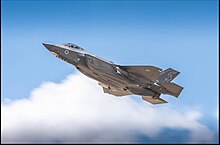Lockheed Martin F-35 Lightning II Israeli procurement
[9] In 2013, it was reported that Israel was building the infrastructure needed to accommodate F-35s, including hardened aircraft shelters, underground pens, and maintenance facilities.However, Israel planned the introduction of a plug-and-play feature added to the main computer to allow for the use of Israeli electronics in an add-on fashion, and to fit its own external jamming pod.[16] The IAF dispatched two officers to the US where they discussed issues involving the integration of Israeli technology into the fighter with Pentagon and Lockheed Martin officials.[16] Benni Cohen compared the Israel Aerospace Industries command and control system to an iPhone App that would run on top of the central avionics.[26] In 2003, Israel signed a formal letter of agreement, worth almost $20 million, to join the System Development and Demonstration (SDD) effort for the F-35 as a "security cooperation participant" (SCP).[27] The Israeli Air Force stated in 2006 that the F-35 was a key part of its recapitalization plans, and that Israel intended to buy over 100 F-35A fighters at an estimated cost of over $5 billion to replace their F-16s over time.[36][37] Former head of the IAF, retired Major General Eitan Ben Eliyahu, called the American approval of the deal a key test of Israel – United States relations.A number of members of the Israeli General Staff also criticized the high cost of the deal, which would reduce the funds available for investment in weapons for the land forces and navy.[40] The total price tag confirmed by Barak indicated that each aircraft costs about $96 million, with further expenses on training, simulators, spare parts, and the building of maintenance infrastructure.[41] Richard Genaille, deputy head of the Pentagon's Defense Security Cooperation Agency, has said that installing different electronics on the F-35 would be very costly and "probably will not be in the best interest in the long run of" nations that make such changes.[46] In November 2010, Israel was reportedly offered an additional 20 F-35s in exchange for a continued freeze on Israeli settlements in the West Bank,[47] however State Department spokesman P.J.[48][49] Moshe Arens has written that Israel does not need the F-35 to maintain its technological superiority over the Arab countries and would be better off developing its own aircraft that did not have the design compromises of the F-35.[50] Gur Laish, an expert on the IAF with the Institute for National Security Studies (INSS) at Tel Aviv University, wrote a report that indicated that the F-35 would have a deterrent effect with its ability to make pre-emptive attacks on hostile countries before war is declared, such as on Iran's nuclear facilities.[53] While being interviewed by Haaretz in May 2011, Ehud Shani said that "during the last visit by Secretary of Defense Robert Gates to Israel a month ago, we were told that the delay may be shorter than they originally thought."[57] The IAF initially presented a long list of unique and costly requirements for the JSF, but it has accepted that its first F-35s will be almost identical to those of the U.S. Air Force, with only Israeli command, control, computers, communications and intelligence systems installed in them.The plans to add Israeli EW systems, air-to-air and air-to-ground munitions as well as an external fuel tank, were approved in principle but were deferred in order to protect the budgetary framework and delivery schedule.Israeli ground commanders argued that because of the potential threat that the giant and modern Egyptian army would be turned against Israel, it is necessary to establish an additional mechanized division, equipped with Merkava tanks and the new Namer armored personnel carrier.[60] In 2013, Lockheed Martin vice president, Steve O'Bryan, said that they were "examining the feasibility" of adding stealthy conformal fuel tanks manufactured by Elbit Systems.[62] However, ministerial committee member Yuval Steinitz, opposing the IDF plan, believed that order should possibly be halved due to concerns about the F-35's range, payload and maneuverability suiting Israel's needs.[66] In November the Prime Minister's Office announced Israel was exercising that 17 aircraft option, after a unanimous vote of the Security Cabinet in favor, taking the total number of ordered examples to 50.[5] On 6 January, the U.S. Department of Defense restricted the use of the F-35I Adir fighter by any IAF pilots who have a foreign passport, due to information security concerns.

Lockheed Martin F-35 Lightning II procurementIsraelprocureLockheed Martin F-35 Lightning IIIsraeli Air ForceAmikam NorkinIsrael–Hamas wartestbed aircraftFlight Test CenterTel Nof AirbaseNevatim Airbasehardened aircraft sheltersAmir Eshelelectronic warfareplug-and-playElbit Systemsguided bombsair-to-air missilesweapons baycommand and controliPhoneIsrael Aerospace IndustriesOffset agreementJerusalem PostRafael Advanced Defense SystemsPythonIsrael Military IndustriesIran's nuclear ambitionsEhud BarakEitan Ben EliyahuIsrael – United States relationsGeneral StaffUdi ShaniDefense Security Cooperation AgencyEhud ShaniIsraeli Ministry of DefenseNew York CityWalid al-MoallemP.J. CrowleyMoshe ArensTel Aviv UniversitySukhoi Su-57HaaretzSecretary of DefenseRobert GatesAviation WeekU.S. Air Forcethe Pentagondramatic changes in the Middle EastJordanIsrael Defense ForcesEgyptian armyMerkava tanksNamer armored personnel carrierGeneral Dynamics Land Systemsconformal fuel tanksYuval SteinitzIsraeli Defense MinisterAvigdor Libermanrecent clashes with Iran in Syriadronescruise missileHouthisIsraeli airstrikes in YemenThe Jerusalem PostIDF spokespersonWayback MachineOttawa CitizenThe Times of IsraelJoint Strike Fighter programF-35 developmentBoeing X-32Lockheed Martin X-35Lockheed Martin AeronauticsBritish procurementCanadian procurementOther nations' procurementF-35 operatorsPratt & Whitney F135General Electric/Rolls-Royce F136Rolls-Royce LiftSystemGeneral Electric XA100Pratt & Whitney XA101AN/APG-81AN/APG-85AN/AAQ-37 Electro-Optical Distributed Aperture SystemLockheedLockheed Martin1 & 2 Vega3 Air Express4 Explorer5 Vega7 Explorer8 Sirius8-D, E & G Altair9 OrionDL.1 Vega10 Electra12 Electra Junior14 Super Electra414 Hudson18 Lodestar37 Ventura43 HarpoonConstellationL-1049L-1249L-1649 StarlinerEC-121C-130JAC-130DC-130HC-130EC-130EC-130HKC-130LC-130MC-130WC-130E-130JCP-140ExcaliburJetStarL-1011 TristarL-2000Saturn